| Posting Rules | | post new threads post replies post attachments edit your posts is are code is are are are | | Similar Threads | | Thread | Thread Starter | Forum | Replies | Last Post | | | Beersmith | Construction, Maintenance & Refit | 12 | 18-09-2012 12:34 | | | Sailmonkey | Construction, Maintenance & Refit | 14 | 06-03-2010 09:45 | | | rebel heart | Construction, Maintenance & Refit | 21 | 29-06-2009 12:39 | | | mobetah | Construction, Maintenance & Refit | 1 | 10-01-2008 19:58 | Privacy Guaranteed - your email is never shared with anyone, opt out any time.  - CREATE AN ACCOUNT
- Boat Cover Finder
- Bimini Top Finder
- Boat Propeller Finder
- Engine Parts Finder
- Anchor & Dock
- Watersports
- Clothing and Footwear
- Engine Parts
- Cabin and Galley
- Covers and Biminis
- Electronics
- Paint and Maintenance
- Pumps and Plumbing
- Anchor Chains & Ropes
- Boat Fenders
- Boat Mooring
- Boat Protection
- Dock Storage & Protection
- Ladders, Steps, & Platforms
- Top Sellers
 - Fishing Rods
- Fishing Reels
- Fishing Rod & Reel Combos
- Fishing Tools & Tackle Boxes
- Fishing Line
- Fly Fishing
- Fishing Bait & Fishing Lures
- Fishing Rod Holders & Storage Racks
- Fish Finders, Sounders & Sonar
- Trolling Motors
- Fishing Nets
- Fishing Downriggers & Acessories
- Fishing Outriggers & Acessories
- Fishing Kayaks
- Fish Cleaning Tables
 - Inflatable Rafts
- Paddle Boarding
- Paddles & Oars
- Wakeboard, Wakesurf & Ski
- Wakeboard Towers
- Tow Ropes & Handles
- Life Jackets & PFDs
- Snow Sports
- Roof Racks, Carriers, Dollies
  Men's ClothingMen's Footwear- Atheltic Shoes
- Water Shoes
Women's ClothingWomen's Footwear- Fuel Systems
- Sacrificial Anodes & Zincs
- Generator Parts
- Inflatable Boats
- Propeller Parts & Accessories
- Boat Manuals
- PWC Parts & Accessories
 - Fishing Boat Seats
- Offshore Boat Seats
- Ski Boat Seats
- Pontoon Boat Seats & Furniture
- Boat Seat Pedestals & Hardware
- Boat Seats by Manufacturer
- Boat Tables & Hardware
- Boat Seat Covers
- Boat Seat Vinyl
- Floating Boat Cushions
 - Barbeque Grills
- Boat Drink Holders
- Cabin Accessories & Hardware
- Boat Ventilation
- Interior & Cabin Lighting
- Marine Teak Products
- Carbon Monoxide & Smoke Detectors
- Binoculars & Telescopes
 Boat Bimini Tops- Bimini Top Accessories
- Pontoon Bimini Tops
- Other Biminis
- RV & Trailer Covers
- Boat Shrink Wrap & Accessories
- Boat Shelters
Boat Covers- Boat Cover Accessories
- Boat Lift Canopy Covers
- Other Covers
- Boat Wiring & Cable
- Marine Batteries & Accessories
- Marine DC Power Plugs & Sockets
- Marine Electrical Meters
- Boat Lights
- Marine Electrical Panels & Circuit Breakers
- Power Packs & Jump Starters
- Marine Solar Power Accessories
- Marine Electrical Terminals
- Marine Fuse Blocks & Terminal Blocks
- Marine Switches
- Shore Power & AC Distribution
 - Marine Audio & Video
- GPS Chartplotters & Accessories
- Electronic Navigation Charts & Software
- Digital Instruments
- Display Mounts
- VHF Radios & Communication
- Marine Radar
- Auto Pilot Systems
- Action Cameras
 - Fiberglass & Epoxy Boat Repair
- Boat Paint & Varnish
- Marine Adhesives, Sealant, & Caulking
- Marine Engine Maintenance
- Boat Cleaners & Waxes
- Boat Cleaning Supplies
 - Fresh Water Boat Systems
- Bilge Pumps
- Marine Plumbing Parts
- Wash Down Pumps
- Livewell Aerator Pumps & Live Bait Wells
- Toilet & Waste Pumps
- Marine Pump Replacement Parts
 - Tires, Rims, & Hub Kits
- Boat Trailer Winches
- Boat Motor Supports & Transom Savers
- Boat Trailer Guides & Rollers
- Boat Trailer Fenders
- Boat Trailer Lights
- Boat Trailer Hardware
- Boat Trailer Jacks
- Boat Trailer Brakes & Axles
- Boat Trailer Tie Downs
- Couplers, Mounts, Hitches, & Locks
 - Boat Deck Harware
- Marine Nuts, Bolts, & Screws
- Boat Handles, Pulls, & Rings
- Prop Nut Kits & Hardware
- Boat Cabin Hardware
- Marine Fasteners
- Boat Windshield Parts
- Boat Tubing & Rails
- Boat Mirrors
- Marine Tools & Tool Kits
- Boat Lettering
 - Women's Clothing Deals
- Men's Clothing Deals
- Fishing Deals
- Anchor & Dock Deals
- Electrical Deals
- Electronics Deals
- Paint & Maintenance Deals
- Pumps & Plumbing Deals
- Boat Seats Deals
- Trailering Deals
- Camping & RV Deals
- Dealer Login
  - Search forums
- The iboats forum moderators are excited to announce that at this time it appears the iboats forums posting pictures function is working once again. Though we cannot promise for how long, we're hoping for indefinitely.
- Boat Repair and Restoration
- Boat Restoration, Building, and Hull Repair
1991 Formula 242 Stringer & Bulkhead Repairs w/ Many Pics- Thread starter tpenfield
- Start date Mar 3, 2012
 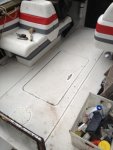 FriscoboaterRe: 1991 Formula 242 Stringer & Bulkhead Repairs Re: 1991 Formula 242 Stringer & Bulkhead Repairs I am glad you are using the photobucket method. I hate clicking the little pictures. The rot does not look terrible, but there is some fixing that needs to be done. Are you going to remove the fiberglass deck? friscoboater said: I am glad you are using the photobucket method. I hate clicking the little pictures. The rot does not look terrible, but there is some fixing that needs to be done. Are you going to remove the fiberglass deck? Click to expand... Re: 1991 Formula 242 Stringer & Bulkhead Repairs Re: 1991 Formula 242 Stringer & Bulkhead Repairs I thin you are right in there. I think this boat is like my glastron. All the rot was in the back. Re: 1991 Formula 242 Stringer & Bulkhead Repairs Re: 1991 Formula 242 Stringer & Bulkhead Repairs Today, I plan on removing the fuel tank from the boat. It is a 94 gallon tank (as per the certification label), and it has maybe 5-10 gallons in it. My plan is to off-load the remaining fuel (looks like I'll have plenty of lawnmower gas) and then remove the tank. Question: this will be my first fuel tank removal . . . aluminum tank. Other than the basic dis-assembly of straps, hoses, sender wiring, etc. is there anything that I should be keenly aware of? I am also wondering how much it is going to weigh . . . it is about 7 feet long and 2 feet wide . . . the certification label says "0.125 gauge" (so I assume that is the thickness of the aluminum). I am figuring around 75-100 lbs, but that is just a guess. T.I.A.  WoodonglassSupreme mariner. Re: 1991 Formula 242 Stringer & Bulkhead Repairs Re: 1991 Formula 242 Stringer & Bulkhead Repairs I'm thinkin if she's as good as you say she is going forward, then You could cut out the bad and "Sister" in the stringers going to the stern and replace the bulkheads and motor mounts and transom. Shouldn't be a problem. Woodonglass said: I'm thinkin if she's as good as you say she is going forward, then You could cut out the bad and "Sister" in the stringers going to the stern and replace the bulkheads and motor mounts and transom. Shouldn't be a problem. Click to expand... Re: 1991 Formula 242 Stringer & Bulkhead Repairs Re: 1991 Formula 242 Stringer & Bulkhead Repairs Today, I checked the structure to find where all the rot is located . . . I drilled holes, etc. to see where I could find solid wood versus rot. The engine compartment uses thru-bolted engine mounts, so there are actually 2 stringers on each side. The inboard stringers, where the engine mounts bolt through are hollow almost all the way back to the transom. The outside stringers have some rot started where they meet the bulkhead. I did some research and found that borates and ethylene glycol are useful in killing the rot fungus and related 'bugs' So, I drilled some holes in the top of the stringer that leads to the transom and loaded it up with some E.G. I'm hoping that this will stop the deterioration at the stringers and save the transom, because it will be a few weeks until I can open things up to clean them out and do the repairs. The transom itself looks OK and I have drilled into it in various locations and hit good wood. I will need to do a bit more inspection of the transom, but I'm hoping it is OK.  Re: 1991 Formula 242 Stringer & Bulkhead Repairs Re: 1991 Formula 242 Stringer & Bulkhead Repairs i really like the photo bucket links .... im re reading the thread now... tpenfield said: The inboard stringers, where the engine mounts bolt through are hollow almost all the way back to the transom. . Click to expand... oops! said: thoes are not hollow stringers bud.....they are totally rotten away. the glass must be cut out, stringer replaced, and the shape re glassed. your approach with glass fill and epoxy is iffy......the ratios must be corrrect. use at least 60 or 70% glass to 30 or 40 percent reisn Click to expand... Re: 1991 Formula 242 Stringer & Bulkhead Repairs Re: 1991 Formula 242 Stringer & Bulkhead Repairs Stuff em and fill em with What??? Woodonglass said: Stuff em and fill em with What??? Click to expand...   - Forum Listing
- Marketplace
- Advanced Search
- About The Boat
- Sailboat Design and Construction
- SailNet is a forum community dedicated to Sailing enthusiasts. Come join the discussion about sailing, modifications, classifieds, troubleshooting, repairs, reviews, maintenance, and more!
Sailboat bulkhead material and LocationI'm really using this forum to gear up for a project, thank you very much. Marine plywood versus standard pressure treated plywood as an alternative for a bulkhead material? Marine plywood needs to be shipped in from Seattle...I can grab a sheet of 3/4" pressure treated right off of the shelf. Any issues with this that folks can comment on? Follow up, I've been reading about some folks using a fiberglass G-10 panels in a West System write-up as well for an alternative. Also, Location....is there any reason not to remove a bulkhead while the boat is in the water....structurally or is this a boatyard repair. I can shore up the lateral as required, however without load...mast removed and shrouds not connected, cabin deck supported internally...is there a flex issue with the boat simply floating without a main bulkhead?  I replaced my starboard side bulkhead recently and used marine plywood because I had ready access to it for a fair price. In retrospect, I am not sure it was necessary because I ended up coating the piece with epoxy and strengthing areas with additional layers of fabric. The marine ply is clearly superior to the standard and I have a greater level of confidence in the repair. Also my boat is 7.3 meter and will not have the same load as your Cal. West Systems Epoxy Works had a good article on a bulkhead repair where an even more $$ and exotic material was used Yes, I read that article and looked at the composite board material! $$ is right....but bulletproof. Thanks.  Thanks Sailingdog. Great point on the toxicity. I was thinking simply on durability and not that I'd have to be living next to it.  Marine plywood has a couple advantages ...extra ply and no voids..been told same glue is in exterior ply so thats no better...but for a bulkhead that will be reinforced anyway I would not pay special fright and or wait for it to arrive just to have it but would go with 3/4 inch cc plugged ex tier... Pressure treated ply also is not as stiff due to the impregnation process...it warps a lot easier under loads...so I would not use it for a bulk head...I wish Bayliner would have used it for transoms in their boats though...they would not have such a rot issue... You will be fine pulling your main bulk head under the conditions you listed still in the water... My feeling on these type of questions is that the labor of the job (your time)is exponentially more expensive than the materials and often you are short changing yourself by choosing a less expensive material over the one you know is better. Just my two cents but I have found that after spending 80 or so hours (WAG) on a job like this it's easy to regret saving $50-75 or so bucks for cheaper materials. Good marine plywood cuts much cleaner, the plys are usually finer grain, is vastly stiffer as Stillraing points out, has no voids, and will provide the right answer for the next potential owners survey. Whichever way you go, good luck with the project I can understand the difficulty you face, if the proper material is not available. Would your supplier be willing to put a few sheets of marine ply on his next shipment of material, and perhaps split the freight with you? Whatever you use, I would echo the others and say use the best you can get your hands on. It isn't an easy job to begin with, and it would be a shame to see first class labor with second rate materials. From my own expierience I would advise that once the piece is cut and test fit that you seal all the edges with thickened epoxy, two coats is best, and then tab to the hull well. Your bulkheads may never have rotted if the edges were sealed well. Wooden boats can funcion well indefinately with water inside, but plywood fairs poorly to being even damp for long periods. Do the job well and be pleased with the result. Feetup Great stuff guys....thank you very much. Marine Ply it is an take my time. Top Contributors this Month J22 Ives Knoll - Main Bulkhead Replacement project Our club J22 fleet is aging and two boats required new main bulkheads. This page documents the replacement on the main bulkhead in J22 #6 Ives Knoll due to rot at the port side chainplate. There are also some other minor repairs documented here.  Ready for last glass work on a beautiful day  Bulkhead weakened at chainplate on port side The first step was to create a template of the existing bulkhead. This was done using cardboard on the previous boat (J22 #5) and we had created pressboard templates for port and stbd halves of the bulkhead. These pieces were test fitted and some minor modifications made. Once we were happy the chainplates and all other hardware caps and fiddles were removed from the existing template and a proper test fitting was completed.  Templates aligned on the Coosa board to cut new bulkhead core.  Pink coloured pencil was the best contrast  New core pieces cut.  Test fitting the new core pieces The templates were oriented on the coosa core material in a manner to produce the least wastage. Then they were traced in pink coloured pencil and cut using a jigsaw. Back in the boat they were placed against the existing bulkhead to ensure a proper fit. A minor modification and we were happy with the fit and ready to proceed with the demolition stage.  Old bulkhead mostly removed  Old bulkhead removed. Now cleaning up leftover edges  The last bits of the old bulkhead chiselled out. Ready for grinding  Grinding complete. A lot of mess!  Gelcoat removed for tabbing and the mess mostly cleaned up. Ready for new bulkhead. With the templating process ccompleted it was time to remove the old bulkhead. Despite being rotted at port chainplate the rest of the bulkhead and the tabbing was very strong and difficult to remove. Tools of choice were Reciprocating saw, angle grinder with cutting disc, cordless drill, BFH (Big F...ing Hammer), prying tools, wood chisels. Initially a 3/8 inch bit on cordless drill was used to make a hole for the saw. Then we cut around the edges of the bulkhead and applied liberal doses of bashing with the BFH and even some prying to get rid of the bulkhead. The process required frequent changing of blades in the reciprocating saw but eventually the old bulkhead was removed in three pieces. There was still some tabbing and some of the plywood from the old bulkhead attached at the hull. The cutting disc on the grinder took care of the tabbing material and a wood chisel and a lot of patience removed the wood residue. With the bulkhead removed it was time to prep the surfaces. The interior of the J22 is gelcoat. This must be ground away for 5 inches on each side of the bulkhead to allow the new tabbing material to bond to the hull. The angle grinder once again used with a sanding disc. The process was not difficult but very messy. It is even worse due to the cramped and low ventilation conditions inside a J22. Following this process 30 minutes with a shop vac was required to cleanup the large amound of dust and gelcoat residue.  New bulkhead core joined with strip of Biax cloth  New bulkhead assembled and ready for installation To say the interior of a J22 is cramped is an understatement. For Ives Knoll we decided to assemble the bulkhead outside of the boat where the working conditions are much more pleasant. Leaving approx four inches uncoated at the edges for the initial tabbing material both front and back sides of the bulkhead were covered with biaxial cloth. Following this process the exposed edges of the new bulkhead were covered with 6 oz cloth. These are the edges that will be exposed once the installation is complete so the 6 oz cloth makes for a more finished look. We are now ready to install the bulkhead in the boat.  New bulkhead in place and ready for tabbing  First layer tabbing applied. View from forward With the bulkhead now assembled it is time to move back inside the boat. A bit more grinding and some minor persuasion with a rubber mallet and the new bulkhead was in place. It was a very snug fit which is great. With the bulkhead in place the next step was to apply the first layer of tabbing to the forward side of the bulkhead. For this we used 6 inch wide tabbing tape which is basically biaxial cloth that comes on a roll. The aft side will have any gaps around the edges filled with Polyfair and then will also have a layer of 6 inch tabbing. This will be followed by a layer of 8 inch tabbing (biaxial cloth) and then a full covering of forward and aft faces of bulkhead extending 5 inches out on to hull as the final tabbing.  Initial layer tabbing complete fore and aft  Polyfair applied around compression post step. Some cleanup required One interesting side project involved a small gap between the mast compression post step and the new bulkhead. When cleaning up the area around the old bulkhead some edges of the forward tabbing were left in place as a guide to location of new bulkhead. With the new bulkhead tight against these edges there was a 1/4 inch gap between the step and the new bulkhead. One option was to tighten the bolts once bulkhead was complete, however it was decided that this would cause a bend in the bulkhead. Instead we opted to tighten two of the bolts to the point where the fit was tight but the bulkhead not bent prior to tabbing. Then the small gap between the compression step and bulkhead was filled with resin soaked fibreglass mat. With this done Polyfair was used to seal the edges of the gap. As seen in the above photo there will be a sanding required to clean this up after it cures. Cloth will then cover the polyfair up to the edge of the compression step.  2nd layer of Tabbing cloth applied. Ready for final layer cloth  Final layer of cloth fitted and ready for resin  Final layer of cloth complete  Ran out of gelcoat! Now that the bulkhead was tabbed in place it was time to apply a second wider layer of tabbing. The first layer was 6 inch wide and the second 8 inch wide to provide an overlap. 24 hours later we were ready for the final full layer of glass. This was a full covering of the bulkhead and extended its tabbing 5 inches on to the hull. After sanding the bulkhead was still tacky so held the new cloth in place while a genourous amount of resin was applied. Following this was a 24 hour wait for curing, a final light sanding and then gelcoat was brushed on rather than paint. Unfortunately there was only enough to coat the forward face of the bulkhead and a small bit around the chainplates port and starboard. Project on hold pending the arrival of more gelcoat.  Four bolt holes drilled for mast compression post step and 2 limber holes  Port chainplate re-installed  Stbd chainplate re-bedded. Needs screws for cap While waiting for more gelcoat to arrive some final steps of the bulkhead replacement task were undertaken. Most of this involved drilling holes. First the chainplates had to be reinstalled. The temporary caulking was removed at the deck and then using a cordless drill the bulkhead slots were re-shaped thru the fibreglass tabbing. Then the chainplates were put in place, bolt holes drilled and bolted in place. Once that was complete on deck the chainplates and covers were bedded using 3M 4200 adhesive sealant. Thankfully we had enough gelcoat the previous day to apply a coat where the chainplated would sit on the bulkheads and where the chainplates would come thru the tabbing on underside of deck. A final task was to prepare for rebolting the mast compression post step to the bulkhead and to drill limber holes for drainage. Once the final coat of gelcoat is applied the step will be bolted in place.  Port bulkhead with slight bump out for chainplate  Bulkhead installation complete. Just requires hardware bolted in place  Bulkhead complete with chainplates and mast compression step bolted in place. Some cleanup required The gelcoat supply had been replenished and we were ready to complete the bulkhead. However we did notice an odd thing. This J22 had a bulkhead that was thicker than the previous one and we were using the same stock for bulkhead core. This resulted in a finished biulkhead whose aft side was approx 1/8 inch forward of the chainplate holes in the deck. Due to this there was a gap between chainplate and bulkhead where bulkhead meets deck. The chainplates were removed, the painted on gelcoat was sanded off and a patch four layers thick of biaxial cloth was built at chainplate locations port and stbd. In the picture above you can just see this bumpout that removes the gap. With this complete the aft side of the bulkhead was brushed with gelcoat and the bulkhead installation is now complete. The chainplate needed to once again be installed and bedded and the mast compression step bolted to the new bulkhead. Gunwhale Repair  Aft section was in the worst state  Forward the damage was less severe There had been some damage to the port gunwhale in four separate places. Two places were simply cracked gelcoat while the other two were through to the layup material. The section that was aft actually was cracked completely through with the fairing material beneath crumbling while the forward section was surface only. The two small sections with cracked gelcoat need only to be ground faired and new gelcoat applied.  Aft section with damaged material ground out. Nasty  Forward section cleaned up and 3 layers 6oz cloth in place  Aft section with 5 layers cloth The two main areas were ground to remove the damaged material. The one aft had crumbly fairing material inside a hole. This was dug out and replaced with polyfair and then five layers of 6oz cloth were applied. We could not get biaxial cloth to lay flat over this bend so 6 oz cloth was used. The forward area had 3 layers of cloth applied and looks ready for sanding and fairing. The aft section needs to be built up with bit more cloth before it is faired. The other two minor sections require fairing material only. This will be faired using coloidal silica mixed with polyester resin for added adhesion, strength and for its white colour.  First fairing coat applied. It is not white  Port Aft Gunwhale area faired and sanded  Port Fwd gunwhale area faired and sanded One more layer of cloth forward and another aft was applied. Next West 406 coloidal silica was mixed with the polyester resin as a thickener. The intent was that it would be white but instead the colour of the resin won out and the result was an aqua colour. The thickened resin was applied to the four repair areas to fill any hollows and then sanded. A second very thin layer of fairing compound was then applied almost as a skim coat. Once this is sanded the areas will be coated with white gelcoat and sanded with 220 then 400 and 600 grit. Following that rubbing compound. It is our hope that this will blend in with the hull more or less.  Fairing coats complete. Gelcoat brushed on  Closeup shot of repaired area. Close but not exact colour match  Another shot this time from aft. All four repaired areas are visible in this picture Miscellaneous smaller repairs With the major problems addressed we now had to turn to some smaller tasks that needed to be done prior to using the boat. These included rebedding stbd jib track, relpacing stbd cam cleat and drilling and refilling the many holes on deck, in cockpit and on sea hood where hardware had at one time been installed. Once this is complete the bottom will be cleaned and painted and then the boat will be ready for the water.  Sea hood holes drilled and ready for fill  Sea hood holes filled with thickened resin  All the holes filled and ready for sanding The deck, cockpit and sea hood of this boat had a larger number of holes from previously installed hardware. Most of the holes had been sealed with resin but were not flush with the deck while those on the sea hood and cockpit seats had been filled with silicon and had some water intrusion. Our plan was to drill all holes slightly larger, fill with thickened resin and then sand flush. Any water in the core and associated rot would be addressed at a later date. The good news is that all of the holes in the deck were filled with resin and water tight leaving only the sea hood and some areas of the cockpit with possible wet core. In the above pictures you can see holes on the poop deck, cockpit seats forward of the traveller and less visible near the toerail and on bow. This boat at one time had stanchions, pulpit, pushpit and lifelines. When added to the sea hood that makes for a lot of possible places for water intrusion.  Starbord jib cleat needed to be replaced  New jib cleat in place J boats usually have a cam cleat on a bulkhead or coaming beneath the winches for sheets and halyards. The J22 is no exception. The starboard jib cleat was broken and missing parts so was replaced with a shiney new cam cleat.  Fasteners for starbord jibtrack. 2nd bolt from front broken. The aft ones we had removed for bolt sizing  Jib track holes drilled larger and wet core dug out .jpg) Holes filled with thickened epoxy and sandy flush  Holes redrilled for installation of track The starbord jib track had one bolt broken and showed obvious signs of leakage. The track was removed, holes drilled larger, wet core dug out around edge of hole using an allen key. Once this was completed the holes were filled with thickened epoxy, sanded flush with deck, redrilled for fasteners and the track rebedded. Water can no longer get into core around these bolt holes  Ives Knoll washed, waxed, bottom painted and ready to go back in service Frers 33 Persistence J27 Nut Case  - Forums New posts Unanswered threads Register Top Posts Email
- What's new New posts New Posts (legacy) Latest activity New media
- Media New media New comments
- Boat Info Downloads Weekly Quiz Topic FAQ 10000boatnames.com
- Classifieds Sell Your Boat Used Gear for Sale
- Parts General Marine Parts Hunter Beneteau Catalina MacGregor Oday
- Help Terms of Use Monday Mail Subscribe Monday Mail Unsubscribe
rotted bulkhead repair- Thread starter sean
- Start date Aug 6, 2005
- Brand-Specific Forums
- Other Sailboats
Can anyone suggest how to repair rotted bulkheads without hauling out dropping mast and completely replacing everything.... Daniel RabuJust fixed mine I own a 1973 Ericson 32 which had some rot in the port bulkhead where the chainplate entered the deck. I removed the chainplate, dug out all the remouvable rot and applied copious amounts of "Git Rot" a penetrating epoxy that turns weak rotted out wood into "something" very strong and prevents further rot where applied. I then built up the area where there was void with filler mixed epoxy and "rebuilt" the rotted out area of bulkhead, then sanded it smooth. I had a new "L" shaped chainplate cut from stainless steel with the bottom of the "L" reaching the area of bulkhead that had no rot and drilled the holes to mount it. Seven bolts were through the good portion of the bulkhead and six were through the epoxy reinforced portion. Cut a new cover piece out of teak, sanded and varnished the whole thing and Bob's your uncle! It is stronger than before with the loads spread over a much larger area of the bulkhead. Make sure to caulk the cr.p out of the chainplate entry point in the deck with sikaflex or other. Not a drop of water has bothered me since. Sure beats replacing the entire bulkhead. Good luck. (Don't forget to polish the new stainless chainplate if you want it to remain "stain-less". I can you pics if you want.�Daniel Rabu - This site uses cookies to help personalise content, tailor your experience and to keep you logged in if you register. By continuing to use this site, you are consenting to our use of cookies. Accept Learn more…
 | 

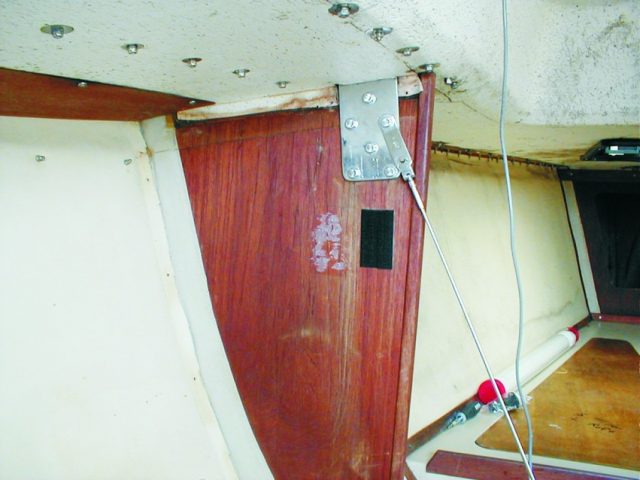
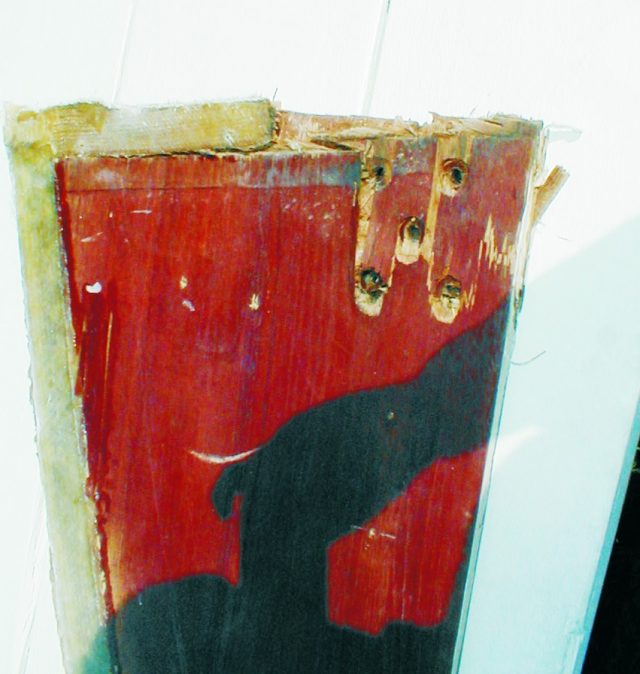
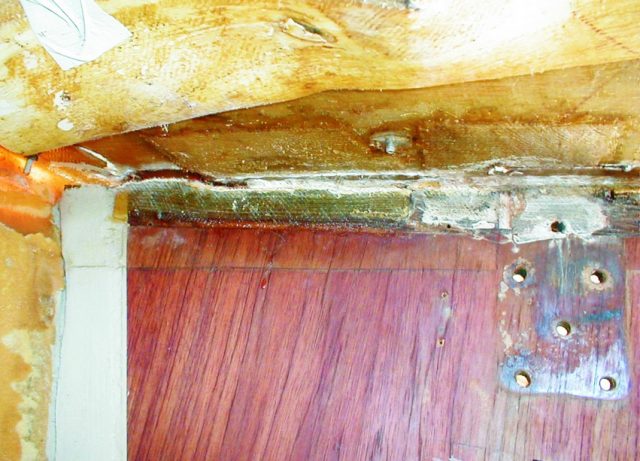
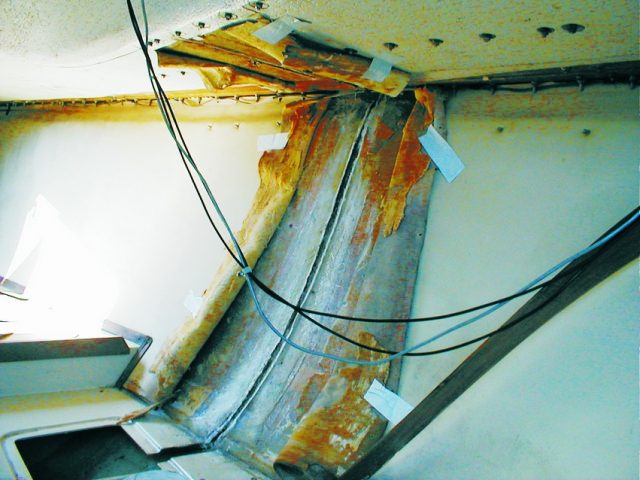
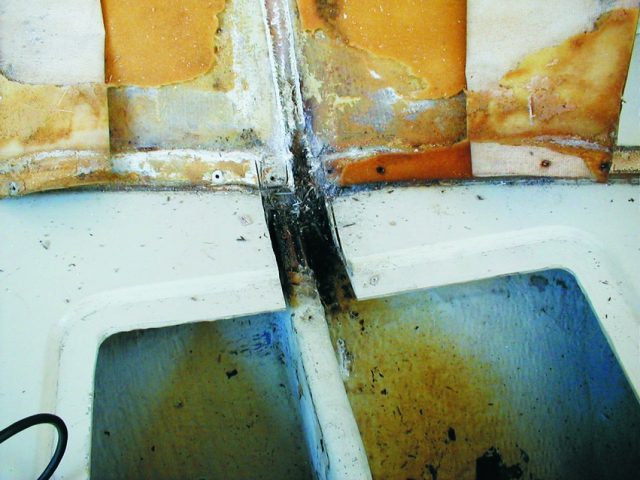
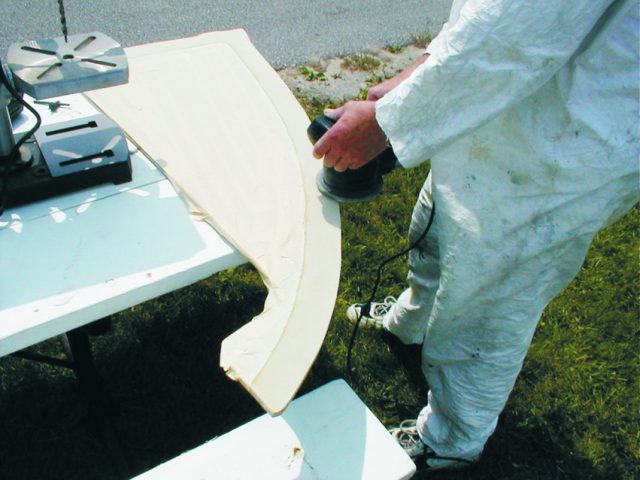
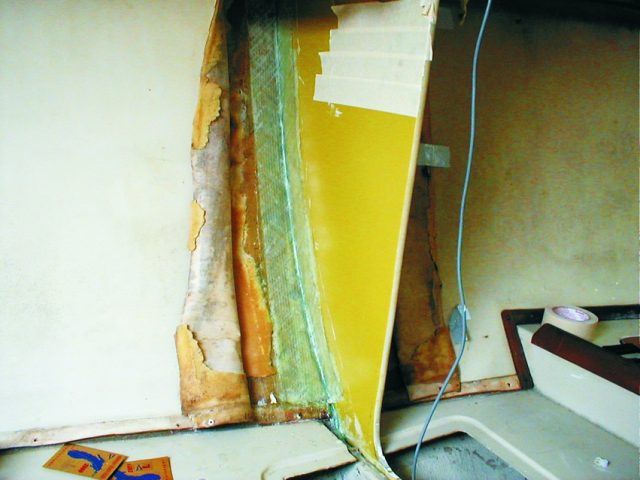


































































.jpg)



IMAGES
VIDEO
COMMENTS
This entry was posted in Boat Repair, Fiberglass Boat Repair and tagged 20, bulkhead, Chicago to Mac Race, Dan Witucki, Epoxyworks #20, Evelyn 32-2, Fall 2002, RUSH, sailboat on November 7, 2014 by ewadmin. Post navigation ← G/5 Adhesive Tips Testing DCPD Blend Laminates →
Want to help support our video productions? Join our One Life Crew here:https://www.patreon.com/SailingOneLifeBig thanks to TotalBoat for all their amazing s...
Using a disposable brush and putty knife, force the mixed resin into the gap between the bulkhead and fiberglass tabbing. Protect your hands with throwaway gloves as this is a messy job. A chemical respirator is recommended in the confined spaces of a boat bilge. Work quickly as the resin in the mixing pot will be "cooking."
Rotted plywood bulkheads. This is, unfortunately, an extremely common problem in production boats, especially around the bulkhead where the chainplates are attached. I once found what appeared to be a great deal (it wasn't) on a well-known production 27-footer. Cosmetically the boat looked good and was well equipped.
How to repair a bulkhead, and fix the tabbing on the hull of a sailboat before the titanium chain plates rip right out! Often Bulkhead repair is needed even ...
In this video im working on my hunter 30 getting it ready for the sailing season. I noticed two of my chain plates where being pulled out of the deck. upon f...
the boat. Bulkhead tabs repair are only as strong as the penetration of epoxy resin into the gap between the tab and the bulkhead. Small wooden wedges may be used to open this gap temporarily while resin is brushed into it. Cut shallow angle wedges from scrap wood. Two are needed. "Hop scotch" one wedge ahead of the other as you work around the ...
Apr 30, 2014. #12. If you go to the Catalina factory website, and look up the chain plate replacement kit, you'll find that now it is U bolts. They are mounted with an aluminum 90 degree "angle iron" plate. Another plate anchors the bulkhead to the bottom of the fiberglass shelf. This continues in the Stb side.
1) Cut and remove fiberglass tabs that hold bulkhead in. 2)once bulk head is out inspect entire bulkhead for dry rot. 3)every three inches or so drill a hole into bulkhead from the edge about 10inches into it. 4) inject penetraing epoxy into each hole. 5) let cure for a few days in the garage.
Jan 12, 2021. #1. I'm in the process of doing some repairs on my '83 Ericson 30+. There is a small plywood bulkhead that is at the forward end of the V-berth, just under the anchor chain pan. It has extensive water damage with the part of the top cross piece and part of the starboard vertical section rotted through. The plywood is tabbed in place.
I can't sail the boat untill this is repaired. Now the hard part is how do i repair this? Pretty much an area around the chainplate going out for 4-6'' in all directions is rotted. The rest of the bulkhead is solid. Ive been thinking i could just cut out the bad section and add in a new piece of wood and fibreglass it to the old bulkhead and hull.
Location: Carlsbad, CA. Boat: 1976 Sabre 28-2. Posts: 7,505. Re: Rotten Bulkhead Repair. You don't need or really want to use teak plywood. The teak is only a veneer with the rest of the plywood something else. AC exterior plywood would probably work just fine or marine ply if you don't care about the expense.
It a full day of work to pull and put the replacement back in. No matter how well you template the new bulkhead, there will need to be adjustments made that you'll discover upon installation. So bring a chisel and a good rasp as well as a belt sander. Total cost if I remember was about $250 with everything.
The only way to fix this ROTTEN BULKHEAD was to CUT IT OUT of this worn-out Liberty 458 restoration sailboat. Now… How am I going to get it back in?!?!I have...
Re: 1991 Formula 242 Stringer & Bulkhead Repairs. That sounds like a very logical and "do-able" plan. Here's a drawing of how I sister joints. Just a butt joint with 3/8" or 1/2" plywood 36" (18" to each side of joint) "Sisters" on both sides, epoxied and deck screwed into the stringers.
54 posts · Joined 2006. #2 · May 5, 2008. I replaced my starboard side bulkhead recently and used marine plywood because I had ready access to it for a fair price. In retrospect, I am not sure it was necessary because I ended up coating the piece with epoxy and strengthing areas with additional layers of fabric.
J22 Ives Knoll - Main Bulkhead Replacement project. Our club J22 fleet is aging and two boats required new main bulkheads. This page documents the replacement on the main bulkhead in J22 #6 Ives Knoll due to rot at the port side chainplate. There are also some other minor repairs documented here. Ready for last glass work on a beautiful day.
Yakutia (officially Republic of Sakha) Constituent republic of the Russian Federation, in ne Siberia; the capital is Yakutsk.The region is bounded by the Laptev and East Siberian Seas (n) and the Stanovoy Range (s).It is the largest Russian republic and one of the coldest inhabited regions, with more than 40% of the territory within the Arctic Circle.
In this video, I do a bit of bulkhead beautification aka cover the bulkheads in 4 mm plywood. Link to webshop: https://saillifeshop.com/ *** Links ***Sail Li...
Can anyone suggest how to repair rotted bulkheads without hauling out dropping mast and completely replacing everything.... Menu Menu. Search. Search titles only. By: Search ... Boat Info. Downloads Weekly Quiz Topic FAQ 10000boatnames.com. Classifieds. Sell Your Boat Used Gear for Sale. Parts. General Marine Parts Hunter Beneteau Catalina ...
Sakha, [a] officially the Republic of Sakha (Yakutia), [b] is the largest republic of Russia, located in the Russian Far East, along the Arctic Ocean, with a population of one million. [11] Sakha comprises half of the area of its governing Far Eastern Federal District, and is the world's largest country subdivision, covering over 3,083,523 square kilometers (1,190,555 sq mi). [12]
In 1992, Yakutsk had a population of over 250,000 people, is the capital of the largest region in Russia, and is centered in an area of enormous natural resources. Yakutsk has Sister City agreements with Fairbanks, Alaska, USA, Guirin (China), Muroyama (Japan), and Darmstadt (Germany). The city is also the home of Yakutsk State University ...
The Sakha (Yakut), a people who formed from the mixture of local tribes with Turkic groups that migrated from the south in the 6th-10th centuries ce, joined the Russian state in the first half of the 17th century.Yakutsk, the republic's largest city, was founded in 1632. In 1638 the Yakutsk province was established and the area was opened to Russians, who settled in the towns along the ...